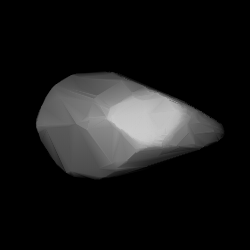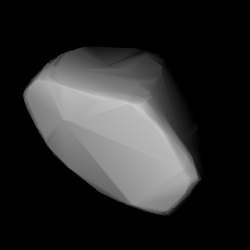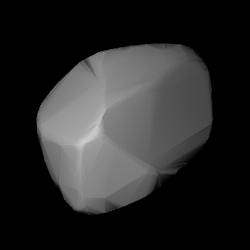
1743 Schmidt, provisional designation 4109 P-L, is a dark background asteroid from the inner regions of the asteroid belt, approximately 19 kilometers in diameter. It was discovered during the Palomar–Leiden survey on 24 September 1960, by astronomers Ingrid and Cornelis van Houten at Leiden, on photographic plates taken by Tom Gehrels at Palomar Observatory in California. The C-type asteroid has a rotation period of 17.5 hours. It was named for the optician Bernhard Schmidt.
Lagrangea, provisional designation 1923 OU, is a carbonaceous background asteroid from the outer region of the asteroid belt, approximately 30 kilometers in diameter. It was discovered on 12 September 1923, by Russian astronomer Sergey Belyavsky at the Simeiz Observatory on the Crimean peninsula. The asteroid was named after Italian mathematician and astronomer Joseph-Louis Lagrange.

1012 Sarema is a dark background asteroid from the inner regions of the asteroid belt, approximately 21 kilometers kilometers in diameter. It was discovered on 12 January 1924, by German astronomer Karl Reinmuth at the Heidelberg-Königstuhl State Observatory at Heidelberg, Germany. The asteroid has a rotation period of 10.3 hours and probably an elongated shape. It was named after Sarema, a character in the poem The Fountain of Bakhchisaray by Aleksandr Pushkin, and the protagonist of the opera Sarema by Alexander von Zemlinsky based upon it.

1039 Sonneberga, provisional designation 1924 TL, is a dark background asteroid, approximately 34 kilometers in diameter, located in the central region of the asteroid belt. It was discovered on 24 November 1924, by German astronomer Max Wolf at Heidelberg Observatory in southwest Germany. The asteroid was named for the German city of Sonneberg, where the Sonneberg Observatory is located.
1092 Lilium, provisional designation 1924 PN, is a dark, carbonaceous background asteroid from the outer regions of the asteroid belt, approximately 44 kilometers in diameter. It was discovered on 12 January 1924, by German astronomer Karl Reinmuth at the Heidelberg Observatory in southwest Germany. The asteroid was named after the flower Lilium.

1118 Hanskya is a large background asteroid, approximately 77 kilometers in diameter, located in the outer regions of the asteroid belt. Discovered by Sergey Belyavsky and Nikolaj Ivanov in 1927, it was named after Russian astronomer Aleksey Hansky. The presumed dark C-type asteroid has a rotation period of 15.6 hours.
1232 Cortusa, provisional designation 1931 TF2, is a background asteroid from the outer regions of the asteroid belt, approximately 40 kilometers (25 miles) in diameter. It was discovered on 10 October 1931, by astronomer Karl Reinmuth at the Heidelberg Observatory in southwest Germany. The X-type asteroid has a rotation period of 25.2 hours. It was named after the plant Cortusa and indirectly honors astronomer Gustav Stracke.
1295 Deflotte, provisional designation 1933 WD, is a carbonaceous asteroid from the outer regions of the asteroid belt, approximately 48 kilometers in diameter. It was discovered on 25 November 1933, by French astronomer Louis Boyer at the Algiers Observatory in Algeria, North Africa. The asteroid was named after the discoverer's nephew.
1524 Joensuu, provisional designation 1939 SB, is a carbonaceous asteroid from the outer region of the asteroid belt, approximately 42 kilometers in diameter. It was discovered on 18 September 1939, by Finnish astronomer Yrjö Väisälä at Turku Observatory in Southwest Finland, and named for the town of Joensuu.
1300 Marcelle, provisional designation 1934 CL, is a carbonaceous asteroid from the middle region of the asteroid belt, approximately 30 kilometers in diameter. It was discovered on 10 February 1934, by French astronomer Guy Reiss at the North African Algiers Observatory in Algeria.

4547 Massachusetts is a dark background asteroid from the central regions of the asteroid belt, approximately 24 kilometers in diameter. It was discovered on 16 May 1990, by Japanese astronomers Kin Endate and Kazuro Watanabe at the JCPM Sapporo Station on the island of Hokkaido, Japan. The asteroid was named for the U.S. state of Massachusetts.

1197 Rhodesia, provisional designation 1931 LD, is a dark background asteroid from the outer regions of the asteroid belt, approximately 48 kilometers in diameter. It was discovered on 9 June 1931, by South African astronomer Cyril Jackson at the Union Observatory in Johannesburg. The likely C-type asteroid has a rotation period of 16.1 hours. It was named for Rhodesia, a former British colony and unrecognised state, which is now Zimbabwe.

1436 Salonta, provisional designation 1936 YA, is a dark background asteroid from the outer regions of the asteroid belt, approximately 60 kilometers in diameter. Discovered by György Kulin at the Konkoly Observatory in 1936, the asteroid was later named for the Romanian city of Salonta, the birthplace of the discoverer.

1424 Sundmania is a large asteroid and rather slow rotator from the background population of the outer regions of the asteroid belt. It was discovered on 9 January 1937, by astronomer Yrjö Väisälä at the Turku Observatory in southwest Finland. The dark X-type asteroid has a notably long rotation period of 93.7 hours and measures approximately 70 kilometers in diameter. It was named after Finnish astronomer and mathematician Karl F. Sundman.
1323 Tugela, provisional designation 1934 LD, is a dark background asteroid from the outer regions of the asteroid belt, approximately 60 kilometers in diameter. It was discovered on 19 May 1934, by South African astronomer Cyril Jackson at the Union Observatory in Johannesburg. The asteroid was named for the Tugela River in western South Africa.

2120 Tyumenia is a dark background asteroid, approximately 45 kilometers in diameter, located in the outer regions of the asteroid belt. It was discovered on 9 September 1967, by Soviet astronomer Tamara Smirnova at the Crimean Astrophysical Observatory in Nauchnyj, on the Crimean peninsula. The asteroid was named for the now Russian district of Tyumen Oblast in Western Siberia.
1585 Union, provisional designation 1947 RG, is a dark background asteroid from the outer regions of the asteroid belt, approximately 52 kilometers in diameter. It was discovered on 7 September 1947, by South African astronomer Ernest Johnson at the Union Observatory in Johannesburg, South Africa. The asteroid was named after the discovering observatory.
3682 Welther, provisional designation A923 NB, is a background asteroid from the central regions of the asteroid belt, approximately 19 kilometers in diameter. It was discovered on 12 July 1923, by German astronomer Karl Reinmuth at the Heidelberg Observatory in southwest Germany. The asteroid has a rotation period of 3.6 hours. It was named after Barbara Welther, an American historian of science at CfA.
1242 Zambesia is a dark background asteroid from the central regions of the asteroid belt, approximately 48 kilometers in diameter. It was discovered on 28 April 1932, by South African astronomer Cyril Jackson at the Union Observatory in Johannesburg. The asteroid was named for the large Zambezi basin in southern Africa.
1461 Jean-Jacques, provisional designation 1937 YL, is a metallic asteroid from the outer region of the asteroid belt, approximately 34 kilometers in diameter. It was discovered on 30 December 1937, by French astronomer Marguerite Laugier at Nice Observatory in southern France, who named it after her son Jean-Jacques Laugier.









